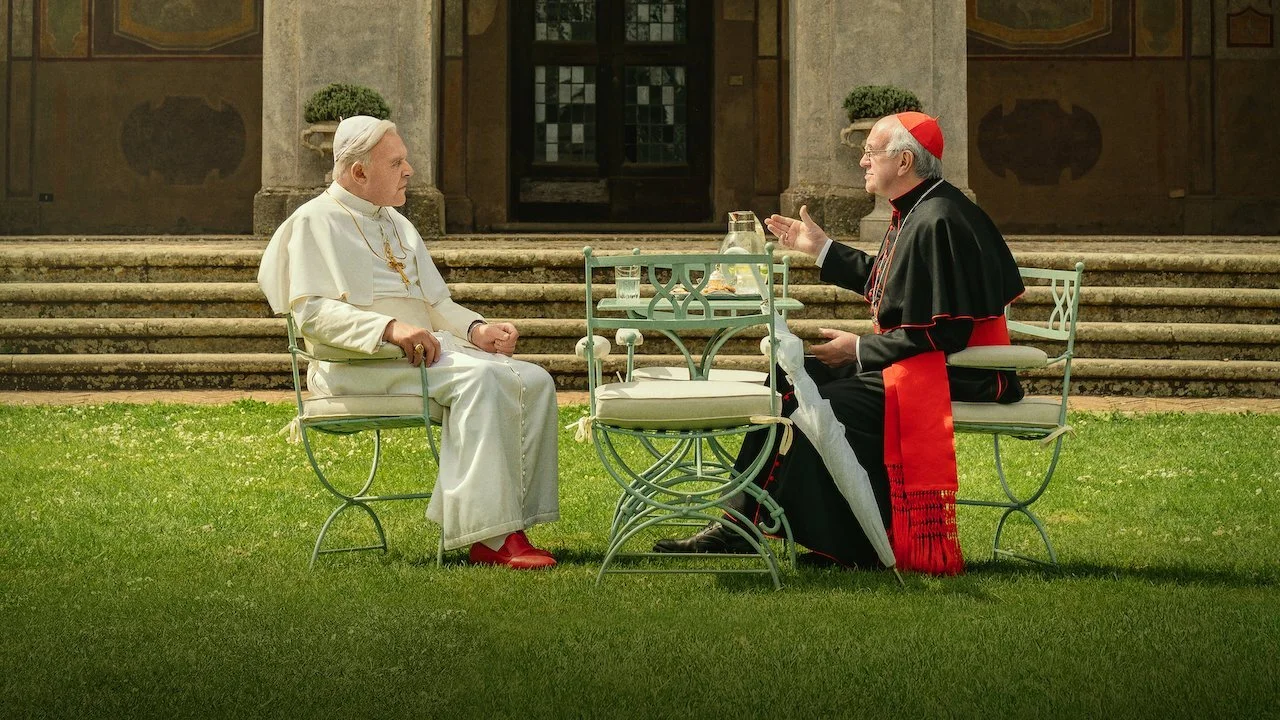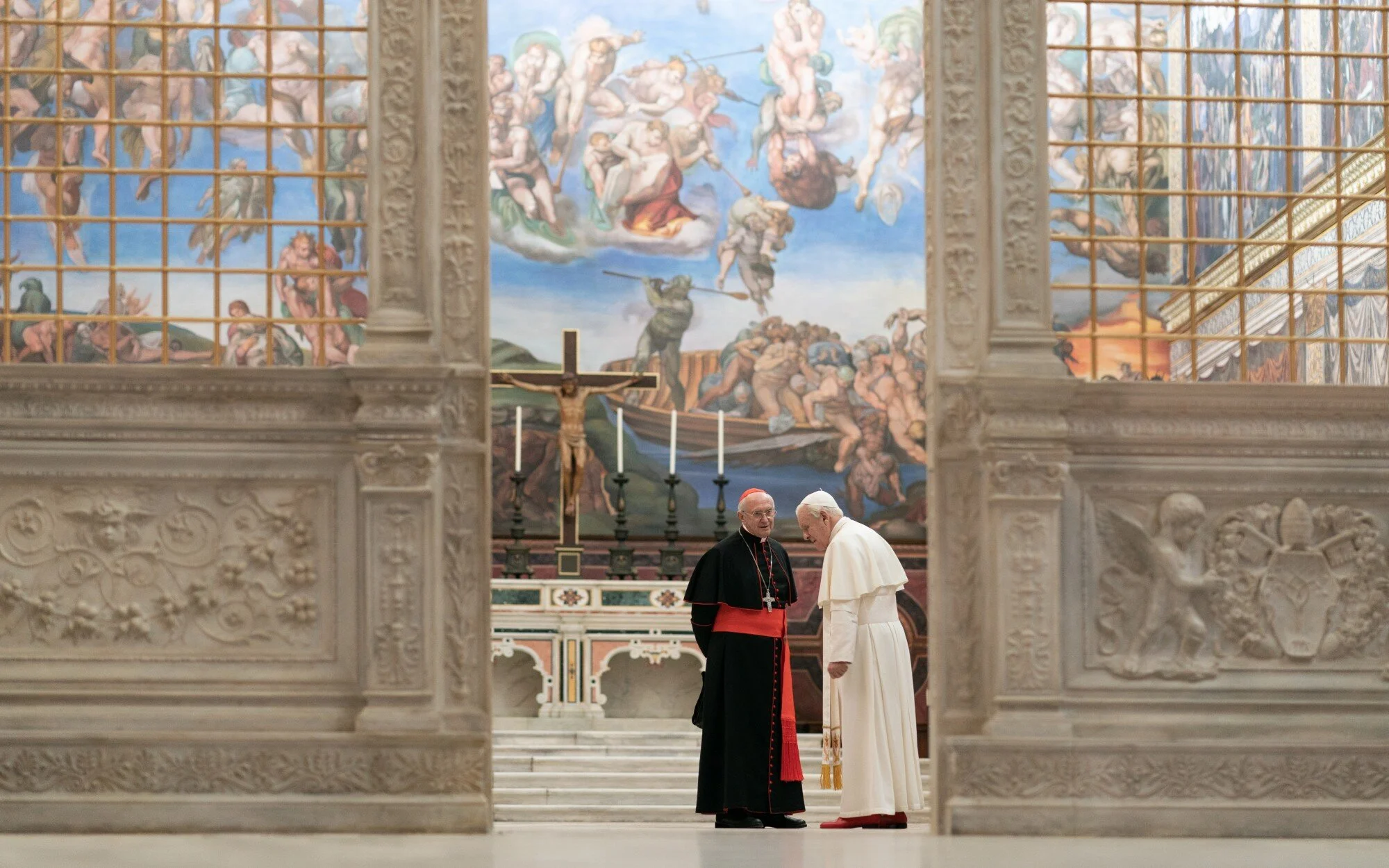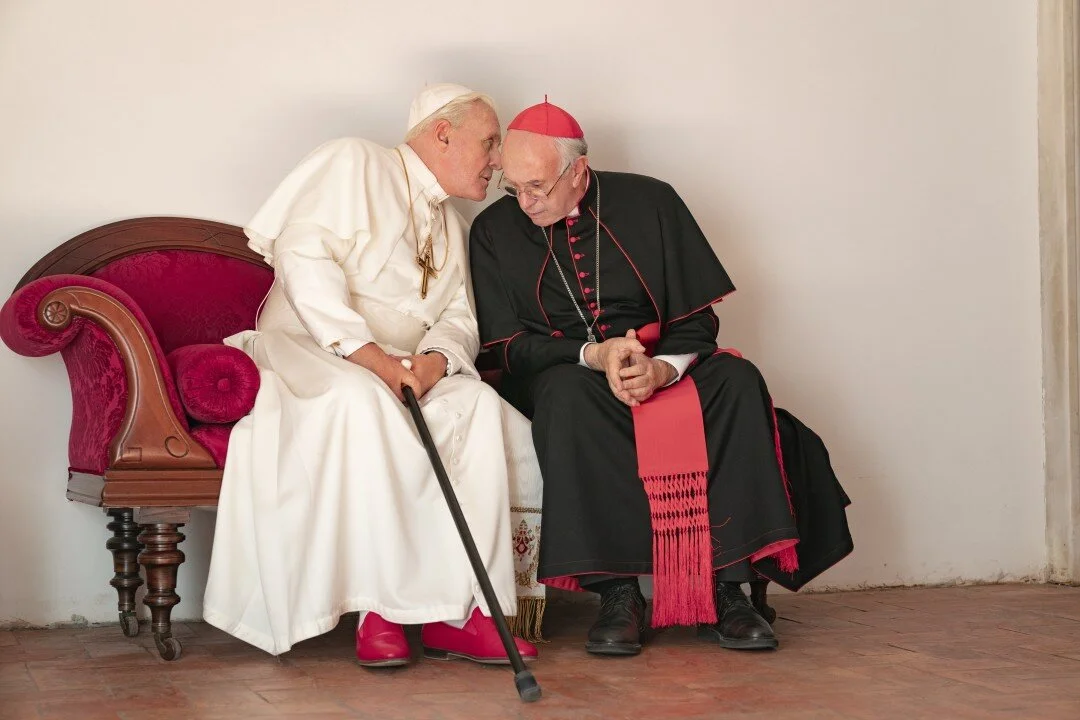Film Review: The Two Popes
©Peter Mountain
This film has two distinct aspects which are as different as the two characters at its center. The personal relationship which develops between Joseph Ratzinger, Pope Benedict XVI (Anthony Hopkins) and his successor Jorge Bergoglio, Pope Francis (Jonathan Pryce) presented as prolonged conversations between the two men in various locations in the Vatican over two intense time periods seven years apart feels like a stage play. And, indeed, the screenplay written by Anthony McCarten is based on his play The Pope. As this is a film, there is the addition of contextual material which is focused on the back story of Archbishop of Buenos Aires, Jorge Bergoglio and how he evolved into the most unconventional and populist pope in history. These two aspects are woven together into a fascinating and dense work, which occasionally feels slightly schizophrenic. However, it does not take away from the enjoyment and edification of watching such a beautiful and moving story.
The deep conversations between the two contrasting characters, portrayed with intense subtlety by these superb actors are dazzling performances. The camera remains in such intimate close-ups that we become aware of every crease and eye movement. The trajectory of their relationship which begins adversarially based on their feelings about the role of the church, and their personal views about their own allegiances, whether to church or the people, could not be more diametrically opposed. It is fully engaging to watch them begin to accept, understand and influence each other, ultimately developing into genuine appreciation and a deep mutual affection.
©Peter Mountain
The film opens in 2005 with Cardinal Bergoglio preaching in the streets of Buenos Aires to a motley crowd of peasants, when he gets word of the death of Pope John Paul II and is summoned to Rome for a conclave to elect a new pope. The contrast between the gritty streets of Argentina could not be more stark when compared with the elaborate refinement and luxuriousness of the Vatican. Bergoglio is immediately resistant to and uncomfortable with much of the excessive deference shown him. He is a simple and humble man, who prefers to carry his own bag and sit in the front of the car next to the driver. He talks to everyone when he is on the streets. He is a curious listener. When he encounters Cardinal Ratzinger at the Vatican, he is casually snubbed.
Ratzinger is highly favored as the next Pope, a position he really wants. He would represent a continuation of the leadership of John Paul II, a direction that many are beginning to feel is too rigid and old-fashioned. The church is losing its membership as it fails to evolve in its attitudes toward women, divorce and homosexuality. Bergoglio has achieved a great deal of attention for his more activist and open-minded attitudes toward these issues as well as his advocacy for the poor and disenfranchised. Ratzinger is chosen by a significant margin. Bergoglio, much to his surprise received the second place in the vote. Ratzinger’s tenure does not go smoothly. There are escalating scandals, both sexual and financial and many are losing faith.
©Peter Mountain
The film cuts to seven years later in Buenos Aires, where Bergoglio is booking a flight to Rome to formally present his resignation as archbishop. The reasons for his resignation are many and heartfelt. He feels at odds with the church’s stated mission and practices on all of the liberal issues, including climate change and the refugee crisis. His activism has escalated and moved beyond the narrow issues of religious dogma into a world view for the Catholic church. This is the basis for their first extended encounter. He has written several letters to the Pope which have remained unanswered. As he is about to leave he finally receives a letter from the Pope inviting him to meet him at the summer residence in the Palacio de Castel Gandolfo.
During their continuing conversations we are introduced to Bergoglio’s back story which outlines his transformation from a promising scientist with a fiancée, through his moment of being called to the priesthood, and becoming a Jesuit. His activities during the revolutionary period in Argentina called the “Dirty War” where tens of thousands civilians “disappeared” in horrific, bloody purges caused some very bad decisions on his part allowing great harm and death to those that he loved. These still weigh heavily on his conscience. Once peace was restored he was denounced and demoted and sent into exile for 10 years. It is during these years that his philosophy on life and the role of the church evolved. These episodes are revealed in flashbacks, often in black and white. This openness on the part of Bergoglio emboldens an equally weighty confession by Ratzinger and the two men take the opportunity to grant confession and absolution to each other. An intensely touching moment.
©Netflix
There are also many humorous and endearing episodes between the two involving soccer, tango, pizza, and Abbey Road. The soundtrack is idiosyncratic including music by ABBA, the Beatles, Smetana, and “Besame Mucho”. The production is thoroughly gorgeous, including a reproduction of the Sistine Chapel on a soundstage. And, let’s face it, nothing beats the Vatican for pomp and circumstance. The formality of the rituals, the gorgeousness of the vestments, the jewels, the accessories, especially the hats. Eye candy for the non-believers. In other words, the weightiness is leavened by sufficient, if sometimes awkwardly inserted, light-hearted moments to leave you uplifted.











